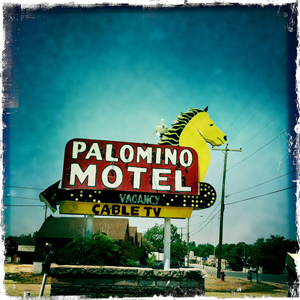By Russell A. Graves
I love road trips. For the past two decades, I’ve made a living as a professional writer and photographer traveling backroads in search of great stories to tell. In the past, planning trips took a little time and effort. Therefore, I’m always interested in the latest technology because it makes me more productive and efficient.
Today road trips are much easier and more spontaneous to plan with the advent of smartphones. With these phones, the paradigm has shifted. Instead of simply carrying a phone with them at all times, now road trippers carry a powerful handheld computer that just happens to make phone calls.
 Hitting the Road – If you count the number of devices smart phones have pushed to near obsolescence, the list is extensive and includes all kinds of gadgets like alarm clocks or wrist watches. It’s also taken the place of common travel accessories. There was a time when I had a dedicated GPS unit that I would switch from car to car when I’d travel. With my IPhone, I have a built-in GPS mapping program that I use to plan my trips. Once on the road, the same device gives me turn by turn directions until I reach my destination.
Hitting the Road – If you count the number of devices smart phones have pushed to near obsolescence, the list is extensive and includes all kinds of gadgets like alarm clocks or wrist watches. It’s also taken the place of common travel accessories. There was a time when I had a dedicated GPS unit that I would switch from car to car when I’d travel. With my IPhone, I have a built-in GPS mapping program that I use to plan my trips. Once on the road, the same device gives me turn by turn directions until I reach my destination.
Besides mapping, I can also prepare for my trip by having an automobile insurance card on my phone, a gas tracking app that helps me identify the cheapest fuel stops along my way, and a playlist customized to play my favorite traveling songs while I’m on the open road. Along the way (while I’m stopped of course), I often check out Wikipedia on my phone’s browser. The Wikipedia mobile site is GPS enabled and will suggest articles of nearby points of interest. It’s a great way to immerse yourself in local culture and learn more about the people and places that make the smallest, most out of the way places interesting.
Photos on the Go – One of the items that smart phones have supplanted from our everyday lives is the dedicated still and video camera. You no longer need to carry a dedicated camera to capture your travel memories. In 2013, camera enabled smartphone sales topped over $1 billion – a 38 % increase over the previous year. During the same time, mid and low-priced point and shoot digital camera sales dropped 36 %.
 For photos, the in-phone camera app is a great place to start. The phone I use has settings for taking standard pictures in a typical 4:3 format, square format, and it even features a panoramic setting. I use the panoramic mode to take wide angle shots from the road and capture big vistas that smaller formats can’t. While the standard camera settings are fine, I like using the apps that utilize the camera and the processing power of the phone’s computer to give pictures a vintage feel. While Hipstamatic is my favorite app, there are a lots of others available on the Apple, Android, or Google formats that add effects like filters, filmstrip borders, frames, light leaks, and other creative embellishments.
For photos, the in-phone camera app is a great place to start. The phone I use has settings for taking standard pictures in a typical 4:3 format, square format, and it even features a panoramic setting. I use the panoramic mode to take wide angle shots from the road and capture big vistas that smaller formats can’t. While the standard camera settings are fine, I like using the apps that utilize the camera and the processing power of the phone’s computer to give pictures a vintage feel. While Hipstamatic is my favorite app, there are a lots of others available on the Apple, Android, or Google formats that add effects like filters, filmstrip borders, frames, light leaks, and other creative embellishments.
For the traveler, one of the greatest tricks that a smartphone camera performs is embedding GPS information in each picture. Now, instead of guessing where pictures were taken once you’ve reached home, a host of low cost photo management software solutions will actually extract the GPS location from the photo and pinpoint the location on a software generated map. These maps are great for saving a trip for serendipity’s sake and re-living the memories at a later date.
Aside from shooting still photos, smart phones these days are equipped with high definition video cameras with impressive results. Add to that the ability to shoot slow motion, use apps to record video with a vintage 8mm look, and on-the-fly editing and posting to social sites like YouTube or Facebook and it’s easy to see that you have a powerful tool that’s capable of faithfully recording and sharing your love of hitting the open road.
Staying in Touch – Speaking of social networking, wouldn’t it be nice if you could take a picture on Instagram and cross post to other social platforms so you can post to all of your friends and followers with a single touch of the screen? You can. Most social apps have the ability to cross post to a variety of networks. If you post to one site, you can post to many other social accounts on the go, all at once. It is a real time saver.
 Speaking of staying connected, when you are away on your weekend getaway, you can completely monitor your home from the road. Most security companies offer ways to monitor your home alarm and watch home security cameras using your smart phone. You can also check to see if doors are locked or unlocked, close or open garage doors, and activate or adjust the thermostat remotely. I use a Nest Thermostat system that I can turn off when I leave, and half an hour or so before I arrive home, I can log in from my phone and turn on the heat or air so the house is comfortable when I walk in the front door after a trip.
Speaking of staying connected, when you are away on your weekend getaway, you can completely monitor your home from the road. Most security companies offer ways to monitor your home alarm and watch home security cameras using your smart phone. You can also check to see if doors are locked or unlocked, close or open garage doors, and activate or adjust the thermostat remotely. I use a Nest Thermostat system that I can turn off when I leave, and half an hour or so before I arrive home, I can log in from my phone and turn on the heat or air so the house is comfortable when I walk in the front door after a trip.
On the Go Journalling – While it goes without saying that you should not divert your attention from the road by looking at your phone, you can use the notes or audio memo app on your phone to speak and record your thoughts. Recording an audio memo is just like it sounds: you talk to the phone and it records your voice verbatim. The notes or other speech recognition apps like Dragon takes your trip journaling a little farther. Using the voice recognition software built into your phone, you can speak to the phone and the voice recognition software transcribes speech to text on the screen. When you get home and you are ready to put your notes with photos or videos, it’s easy to email your notes, edit them in word processing software, and then copy and paste them into a book layout or any other presentation method of your choosing.
I’ve found that I often speak to my phone and take notes on things of interest that I’ve seen, story ideas, great restaurants, or various musings that may come to mind. I’ve always had a good memory and paid attention to details but the ability to take notes without physically writing something down has really taken my efficiency to the next level.
Eating and Sleeping on the Go – There once was a time not too long ago when staying in a hotel or eating a a restaurant in which you were unfamiliar was hit and miss. Although it may be a national food or lodging chain, local variation in management practices may or may not live up to each person’s sensibilities. Many downloadable apps double as a social network that gives input on lodging and dining. The hotels.com app, for example, finds available lodging in a given area, publishes the price, and provides user generated feedback as to the quality of the hotels amenities.
The bottom line is that the technology in your hand lets you focus less on planning and more on traveling. Smartphones are an indispensable tool for road trippers. The best tip however? When you get to that cool location, be sure to turn off your phone for a while and enjoy the view.











